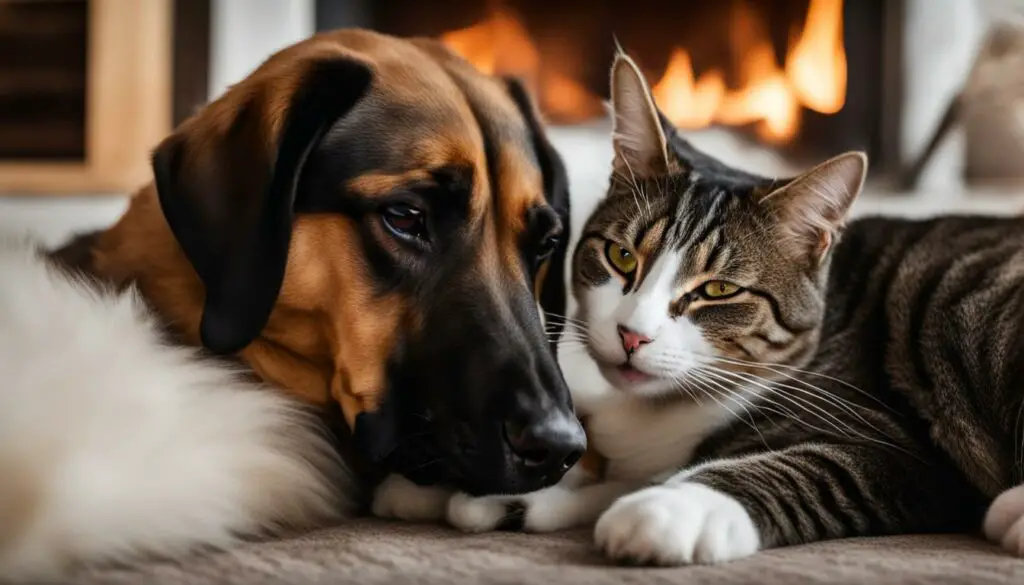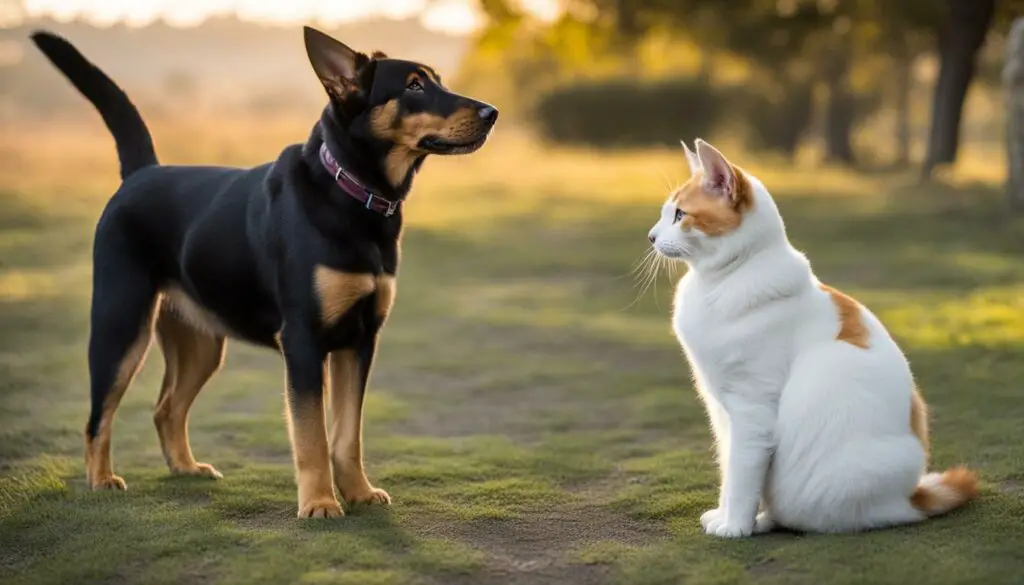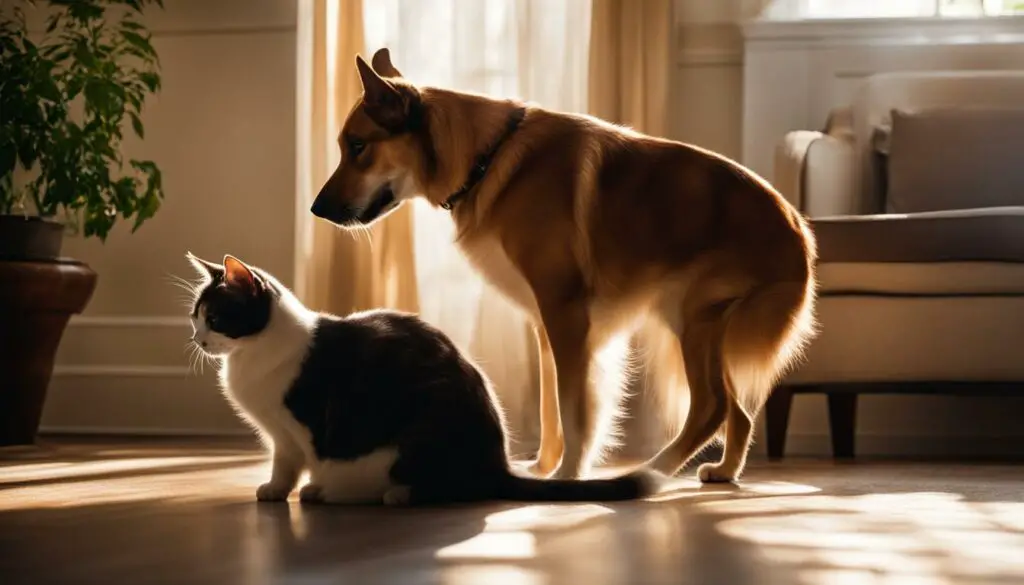Have you ever wondered why your dog licks your cat’s ears? It’s a common behavior that can have various reasons behind it. To understand why dogs engage in this behavior, we need to explore different aspects of their communication, grooming habits, and social dynamics.
Key Takeaways:
- Dogs lick cats‘ ears as a form of communication, grooming, or to establish social hierarchies.
- Understanding the motivations behind dog licking can help create a harmonious environment for your pets.
- Monitoring the interactions between dogs and cats is essential for a positive relationship.
- Excessive or inappropriate licking may require consultation with a veterinarian.
- Setting boundaries and redirecting your dog’s attention can help manage unwanted licking behaviors.
Why Do Dogs Lick?
Dogs are known for their licking behavior, and it serves various purposes in their communication and interaction with humans and other animals. Understanding why dogs lick is essential for pet owners to interpret their behavior and strengthen the bond with their furry friends.
Communication: Dogs use licking as a form of communication. They may lick to express affection, seek attention, or show submission. Licking serves as a way for dogs to convey their emotions and establish social hierarchies within a pack.
Grooming: Licking is also a natural grooming behavior for dogs. It helps them keep their fur clean by removing dirt, debris, and parasites. Additionally, dogs may groom themselves or other animals as a sign of affection and care.
“Licking is a multi-purpose behavior for dogs, allowing them to communicate, groom, and show affection.” – Dr. Amanda Carter, Veterinary Behaviorist
Why Do Dogs Lick Humans?
When it comes to licking humans, dogs often do it as a way to interact and show affection. Licking human skin provides them with close contact and a way to bond with their human companions. It can also be a way for dogs to seek attention or express their love and loyalty.
| Reasons Why Dogs Lick Humans | Description |
|---|---|
| Expression of Affection | Dogs may lick humans as a way to show their love and affection. It is their way of saying “I care about you.” |
| Attention Seeking | Licking can be a dog’s way of seeking attention from their owners. They may lick to get pets, treats, or playtime. |
| Submission | In some cases, dogs may lick humans to show submission and respect. It is their way of acknowledging a higher rank within the social structure. |
Overall, dogs lick for various reasons, including communication, grooming, and affection. Understanding the motivations behind their licking behavior can help pet owners better understand their furry companions and strengthen the bond between them.

Communication and Bonding
Communication plays a vital role in the relationship between dogs and humans. Dogs use various forms of communication to express their needs and emotions, and licking is one of them. When a dog licks a person or another animal, it can be a way to convey affection, seek attention, or establish social hierarchies.
Through licking, dogs can bond with their human companions and strengthen their relationship. This behavior is a display of trust and affection, as the dog seeks closeness and connection with their owner. It is important for pet owners to understand and interpret their dog’s licking behavior in order to respond appropriately and foster a strong bond.
Similarly, when dogs lick cats, it serves as a form of communication and bonding between the two animals. Licking can signify acceptance and acknowledgment, as well as a way to establish social dynamics within their shared environment. It helps create a sense of familiarity and belonging, contributing to a harmonious relationship between dogs and cats.
Overall, communication through licking is a natural behavior for dogs and serves as a means of bonding and expressing emotions. By recognizing and understanding this form of communication, pet owners can strengthen their connection with their dogs and provide a nurturing environment for their furry companions.
The Importance of Communication and Bonding
In the relationship between dogs and humans, as well as dogs and cats, communication and bonding are crucial factors. Effective communication ensures that the needs and desires of both animals are understood and met, while bonding fosters trust, comfort, and emotional well-being.
“Communication through licking is a way for dogs to connect with humans and other animals, allowing them to express affection, seek attention, and establish social hierarchies.”
By actively engaging in communication and bonding activities, pet owners can cultivate a stronger bond with their dogs and cats. This can lead to a more fulfilling and enjoyable relationship, characterized by love, trust, and mutual understanding.

| Benefits of Communication and Bonding | Examples |
|---|---|
| Enhanced understanding | Clear communication allows for better understanding of each other’s needs and desires. |
| Reduced stress and anxiety | A strong bond based on trust and communication helps reduce stress and anxiety in both dogs and cats. |
| Improved obedience and behavior | Effective communication fosters a sense of trust and respect, leading to improved obedience and desired behaviors. |
- Established hierarchy
- Efficient problem-solving
- Increased emotional well-being
By prioritizing communication and bonding, pet owners can create a harmonious environment where dogs and cats can thrive both individually and together.
Grooming
Grooming is an essential behavior for dogs, serving both functional and social purposes. Dogs groom themselves by licking their fur to keep it clean and free from debris. This instinctual behavior helps maintain their overall hygiene and prevents the accumulation of dirt and parasites.
Additionally, dogs also engage in grooming behaviors with other animals as a way to establish and maintain social bonds. When a dog licks another animal, including cats, it can be a sign of affection and care. It reinforces the bond between them and creates a sense of comfort and well-being.
“Grooming behaviors are instinctual for dogs and play a vital role in their overall well-being.”
While dogs licking cats may primarily serve grooming purposes, it’s important to observe their interactions closely. Ensuring that both animals are comfortable and showing no signs of distress is crucial. If excessive licking or discomfort persists, consulting with a veterinarian can help address any underlying issues and ensure the well-being of both pets.

Grooming Behaviors in Dogs and Cats
| Grooming Behavior | Dogs | Cats |
|---|---|---|
| Self-grooming | Dogs groom themselves by licking their fur to remove dirt and parasites. They may also chew on certain areas to alleviate itching or discomfort. | Cats are known for their extensive self-grooming behaviors. They use their tongues to clean their fur, remove dirt, and maintain cleanliness. |
| Social grooming | Dogs engage in social grooming behaviors with other animals, including cats. Licking is a common way for dogs to show affection, establish social bonds, and reinforce their hierarchy within a group. | Cats engage in social grooming behaviors primarily with other cats. They lick each other as a way to strengthen social bonds and establish a sense of belonging within their group. |
| Grooming between dogs and cats | Dogs may groom cats as a sign of affection and care. Licking can serve as a way to build trust, strengthen their bond, and create a harmonious relationship. | Cats may tolerate grooming from dogs if they trust and feel comfortable with them. They may enjoy the attention and see it as a form of social interaction. |
Grooming behaviors in dogs and cats are complex and multifunctional. They serve both practical purposes, such as cleanliness, and social purposes, such as bonding and establishing hierarchies. Understanding these behaviors can help pet owners create a nurturing environment for their pets and strengthen the relationship between dogs and cats.
Why Does My Dog Lick My Cat?
Have you ever wondered why your dog insists on licking your cat? This common behavior can have several reasons behind it, and understanding them can help you create a harmonious environment for your furry friends.

Dogs licking cats can serve multiple purposes. It can be a way for them to strengthen their bond, establish dominance or submission, seek attention or engage in play, alleviate stress or anxiety, or simply show affection. Monitoring their interactions is vital to ensure a positive relationship between them.
Key Takeaways:
- Dogs may lick cats to strengthen their bond and show affection.
- Licking can also be a way for dogs to establish dominance or submit to a higher-ranking cat.
- It’s important to set boundaries and redirect unwanted licking behaviors.
- Excessive or inappropriate licking may require veterinary attention.
- Understanding your dog’s individual needs and behavior is key to addressing their licking habits.
Social Bonding
The interaction between dogs and cats involves various forms of communication, and licking is one of them. When a dog licks a cat, it is often a sign of social bonding. Licking helps dogs build trust and establish a positive relationship with their feline companions. It is a gesture of affection that shows the dog considers the cat an important part of their social group.
By engaging in mutual grooming, dogs and cats strengthen their bond and create a harmonious environment. Licking provides a sense of comfort and reassurance to both animals, fostering a deeper connection between them. It serves as a means of communication that transcends language barriers and helps them express their emotions and intentions effectively.
Understanding the significance of licking in social bonding can help pet owners appreciate the relationship between their dog and cat. It is essential to encourage and facilitate these interactions, as they promote the well-being and happiness of both pets.
| Bonding Behaviors | Description |
|---|---|
| Mutual grooming | Both the dog and cat engage in reciprocal licking to groom each other. |
| Face licking | The dog licks the cat’s face as a display of friendship and affection. |
| Sharing space | The dog and cat spend time together, sharing the same space and showing a sense of companionship. |

The table above illustrates some of the bonding behaviors that dogs and cats exhibit. These behaviors, including mutual grooming, face licking, and sharing space, contribute to social bonding and reinforce the bond between the two animals.
Dominance/Submission
Dogs licking cats can also indicate dominance or submission. Dogs may lick cats to assert their dominance or show deference to a higher-ranking cat. This behavior is part of the complex dynamics between dogs and cats in establishing their social hierarchy.
When a dog licks a cat as a sign of dominance, it is asserting its position as the alpha or leader. The constant licking is a way for the dog to show its authority and establish control over the cat. On the other hand, if the dog is licking the cat in a submissive manner, it is acknowledging the cat’s higher rank and showing respect.
It’s important for pet owners to recognize these dominance/submission behaviors and intervene if necessary. If the licking becomes excessive or if it leads to aggression or discomfort for either animal, it may be necessary to consult a professional trainer or behaviorist to address the issue. They can provide guidance on how to establish clear boundaries and create a more balanced dynamic between the dog and cat.

Stress Relief: How Dogs Licking Cats Promotes Relaxation
When dogs lick cats, it’s not just a gesture of affection or communication; it can also provide stress relief for both animals. Licking has a calming effect on dogs, helping them cope with anxiety or stressful situations. This behavior creates a soothing environment for cats as well, promoting relaxation and overall well-being.
Studies have shown that the act of licking releases endorphins in dogs, which are natural chemicals that promote feelings of pleasure and reduce stress. Therefore, when a dog licks a cat, it can help both animals feel more at ease and find comfort in each other’s presence.
It’s important to note that excessive licking can be a sign of underlying issues and should be monitored. If a dog’s licking behavior becomes obsessive or causes discomfort to the cat, it’s advisable to consult a veterinarian for further guidance and assessment.
The interaction between dogs and cats is complex, and understanding the different motivations behind their behaviors can help pet owners create a harmonious environment. By recognizing that licking serves as a form of stress relief, we can ensure our pets feel safe, secure, and relaxed in their interactions.

Health and Grooming
When dogs lick cats, it not only serves as a form of communication and bonding, but it also contributes to their overall health and grooming. Licking helps remove dirt, debris, and parasites from the cat’s fur, promoting cleanliness and hygiene. Additionally, the act of licking stimulates the production of natural oils in the cat’s skin, which helps keep their coat healthy and shiny.
Grooming behaviors are instinctual for dogs, and by licking their feline companions, they are actively participating in the grooming process. This mutual grooming strengthens the bond between the two animals and creates a sense of comfort and well-being. It demonstrates care and affection, fostering a positive relationship between dogs and cats.
| Benefits of Dog Licking for Cats | Benefits of Dog Licking for Dogs |
|---|---|
|
|
|
|
Overall, dog licking plays a vital role in maintaining the health and grooming of both cats and dogs. It is a natural behavior that should be encouraged as long as it remains gentle and non-aggressive. However, if excessive licking persists or causes discomfort for either animal, it is advisable to consult with a veterinarian for further guidance.

Possible Ear Infection Detection
When dogs lick a cat’s ears excessively, it could potentially indicate the presence of an ear infection. Dog saliva contains antibacterial properties that can help fight certain bacteria, but persistent and excessive licking can be a sign of discomfort or pain. It is important for pet owners to monitor their cat’s behavior and take necessary steps to ensure their well-being.
If you notice your dog constantly licking your cat’s ears and showing signs of agitation or distress, it is advisable to consult a veterinarian. A professional examination can help determine if the cat has an ear infection or any other underlying health issues that may require medical attention.
Keep in mind that excessive ear licking can also result in further irritation and potential damage to the cat’s ears. Therefore, it is crucial to address the issue promptly and seek appropriate veterinary care to prevent any complications.
By being observant of your pets’ behavior and seeking professional advice when needed, you can ensure that your pets receive the necessary care and attention they require.
Setting Boundaries: Managing Your Dog’s Licking Behavior
As a dog owner, you may have wondered why your furry friend has a tendency to lick your cat. While it is a common behavior, it’s important to establish boundaries to maintain a harmonious relationship between your pets. In this section, I’ll discuss the significance of setting boundaries and provide some helpful tips on managing your dog’s licking behavior.

Key Takeaways:
- Setting boundaries is essential in creating a balanced environment between dogs and cats.
- Teaching dogs alternative behaviors and redirecting their attention can help manage excessive licking.
- Positive reinforcement training techniques can be beneficial in reinforcing appropriate behavior.
- Consulting with a veterinarian can provide further guidance if your dog’s licking behavior persists.
- Establishing clear guidelines for your dog’s behavior towards your cat is crucial for a healthy human-dog relationship.
When to Be Concerned
While licking between dogs and cats is generally harmless, excessive or inappropriate licking can be a cause for concern. It’s important to monitor the cat’s reactions and assess the well-being of both animals to determine if intervention is necessary. If excessive licking persists or causes discomfort to either pet, consulting with a veterinarian is advisable.
Excessive licking can indicate underlying issues such as anxiety, stress, or even medical conditions. Cats may become agitated or irritated if they are being constantly licked, and it can disrupt their daily routines. Additionally, dogs that excessively lick may develop skin irritation or other related health problems. Therefore, it’s crucial to pay attention to the frequency and intensity of the licking behavior.
A veterinarian can evaluate the situation and provide guidance on how to address the issue. They may recommend behavior modification techniques, such as positive reinforcement training, to redirect the dog’s excessive licking. In some cases, medical intervention may be necessary to treat any underlying health conditions that could be causing the behavior.
By being proactive and seeking professional advice, pet owners can ensure the well-being of both their dog and cat. It’s always better to address any concerns early on to prevent the behavior from escalating or causing further discomfort to the pets involved. Remember, when it comes to the health and happiness of our furry friends, it’s better to be safe than sorry.
Preventing Unwanted Licking
When it comes to preventing unwanted licking behaviors in dogs, there are several strategies that can be effective. One approach is to provide appropriate chew toys or interactive games that can redirect the dog’s licking behavior onto objects instead of the cat. This not only helps to satisfy their need to lick but also keeps them engaged and mentally stimulated.
Positive reinforcement training techniques can also be used to teach dogs alternative behaviors and redirect their attention. For example, rewarding them with treats or praise when they engage in appropriate behaviors, such as sitting quietly or playing with a toy, can help reinforce these behaviors and discourage excessive licking. Consistency and patience are key when using this training method.
If the unwanted licking behavior persists or becomes a concern, it is advisable to consult with a veterinarian for further guidance. They can assess the situation, rule out any underlying medical issues, and provide specific recommendations tailored to your dog’s needs. Remember, every dog is unique, and what works for one may not work for another, so professional guidance can be invaluable in finding the most effective solution.
In summary, preventing unwanted licking behaviors in dogs involves providing appropriate outlets for their licking instincts, using positive reinforcement training techniques, and seeking professional advice if needed. By taking proactive steps, you can create a harmonious environment for both your dog and your cat, ensuring a happy and healthy relationship.
The Human Response: How to Manage Your Dog’s Licking Behavior
When our dogs lick us, it’s often seen as a sign of affection and love. But what do we do when they start licking our cats? Understanding the human response to this behavior is essential in managing it effectively and creating a harmonious environment for all our pets.

As dog owners, it’s important to set boundaries and reinforce appropriate behavior. While licking may be a sign of affection, excessive or inappropriate licking can be a cause for concern. Ignoring the behavior or redirecting your dog’s attention can help establish clear guidelines and maintain a healthy human-dog relationship.
Key Takeaways:
- Setting boundaries and reinforcing appropriate behavior is crucial in managing your dog’s licking behavior
- Excessive or inappropriate licking should be addressed to ensure the well-being of both your dog and cat
- Ignoring the behavior or redirecting your dog’s attention can help establish clear guidelines
- Positive reinforcement training techniques can be used to teach dogs alternative behaviors
- Understanding and responding to your dog’s needs is key in addressing their licking behavior
Understanding Your Dog
Understanding your dog is crucial for building a strong and fulfilling relationship. Each dog is unique, with their own personality, needs, and communication style. By observing their behavior, body language, and reactions, you can gain valuable insights into what they’re trying to tell you and how to meet their specific needs.
One important aspect of understanding your dog is recognizing their individual motivations and triggers. Dogs may lick for various reasons, such as to communicate, bond, show affection, or alleviate stress. By paying attention to the context and timing of their licking behavior, you can better interpret their intentions and respond appropriately.
Another key aspect of understanding your dog is recognizing their body language. Dogs use a combination of vocalizations, facial expressions, and body postures to communicate their emotions and intentions. For example, a relaxed and wagging tail usually indicates happiness and friendliness, while a stiff body posture and raised hackles may signal fear or aggression. By familiarizing yourself with your dog’s body language, you can better understand their emotional state and address any potential concerns.
Conclusion
In conclusion, understanding why dogs lick cats‘ ears is essential for maintaining a harmonious environment between your pets. Dogs lick for various reasons, including communication, grooming, affection, and social bonding. It can be a way for them to express love, seek attention, or establish dominance or submission. By monitoring their interactions and setting boundaries, you can ensure a positive relationship between your dog and cat.
It’s important to note that excessive or inappropriate licking should be addressed and monitored. While licking can be a normal behavior, it can also indicate discomfort or pain, such as the presence of an ear infection. Consulting with a veterinarian if concerns arise is advisable to ensure the well-being of your pets.
Preventing unwanted licking behaviors can be achieved through redirecting your dog’s attention onto chew toys or interactive games. Positive reinforcement training techniques can also be utilized to teach dogs alternative behaviors. Remember, how you respond to your dog’s licking is crucial in maintaining a healthy human-dog relationship. By setting clear boundaries and reinforcing appropriate behavior, you can create a loving and balanced environment for your pets.
FAQ
Why does my dog lick my cat’s ears?
Dogs may lick cats’ ears for various reasons, including communication, affection, grooming, or social bonding.
Why do dogs lick in general?
Dogs lick as a form of communication, grooming, affection, or to establish social hierarchies.
How does licking contribute to communication and bonding?
Licking is a way for dogs to convey affection, seek attention, or establish social hierarchies with cats and other animals.
Why do dogs groom themselves and others?
Dogs groom to maintain cleanliness, remove dirt and parasites, and bond with owners and other animals.
Why does my dog lick my cat?
Dogs may lick cats to strengthen their bond, establish dominance or submission, seek attention, relieve stress, or show affection.
How does licking contribute to social bonding?
Licking helps dogs build trust, strengthen their bond, and show affection towards their feline companions.
Can licking indicate dominance or submission?
Yes, dogs may lick cats to assert dominance or show deference to a higher-ranking cat.
Can licking help dogs relieve stress?
Yes, licking has a soothing effect on dogs and can help them cope with anxiety or stressful situations.
How does licking contribute to the health and grooming of cats?
Licking helps remove dirt, debris, and parasites from the cat’s fur, promoting cleanliness and hygiene.
Can excessive licking indicate an ear infection?
Excessive licking of a cat’s ears could be a sign of discomfort or pain, indicating the presence of an ear infection.
How can I set boundaries to manage licking behavior?
Teaching dogs alternative behaviors, redirecting their attention, and using positive reinforcement can help manage their licking behaviors.
When should I be concerned about excessive licking?
If excessive licking persists or causes discomfort to either the dog or the cat, consulting with a veterinarian is advisable.
How can I prevent unwanted licking?
Providing appropriate chew toys or interactive games can redirect a dog’s licking behavior, and positive reinforcement training techniques can be used to teach alternative behaviors.
How should I respond to dog licking as a human?
Setting boundaries and reinforcing appropriate behavior through ignoring or redirecting attention can help establish a healthy human-dog relationship.
How can I better understand my dog’s licking behavior?
Observing body language, reactions, and overall behavior can help in understanding and responding to a dog’s licking needs.








